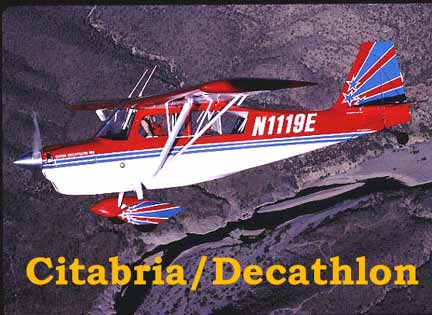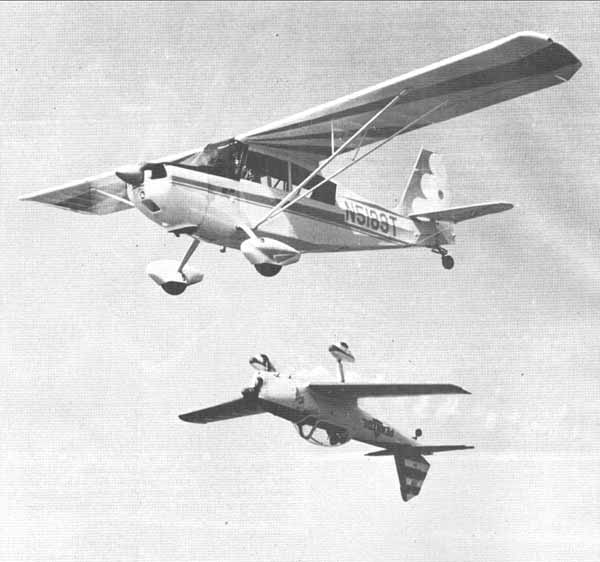
CITABRIA: THE BARGAIN BASEMENT CLOWN
By Budd Davisson, Air Progress. March, 1981
PAGE TWO
 |
|
| Although comic, when compared to a Pitts or hopped up Chipmunk, the Citabria nonetheless became an airshow staple and was seen in some high class company like Art Scholl in his highly modified Chipmunk. |
One of the really long term problems of early Citabrias was their fabric work. An airplane that was regularly akroed could count on the belly fabric coming apart at any time between 200 and 400 hours. With proper taping and some ceconite glue, these problems disappear, but beware of factory fabric. It is basically awful on all but the very latest airplanes.
Wing fairings were another real problem. The PK screws holding
them kept working loose and the fairings would flap in the
wind. Also, fuel tanks, in the early birds, were really fond
of leaking, especially those in the 150 hp, fuel injected airplanes,
because they saw more inverted work. Today, however, most of
the tanks that were going to leak, have leaked, and theoretically
should have been repaired. The first fiberglass doors also
had a neat trick; in inverted flight, if you forgot the top
latch, they'd snap in half with a tremendous bang. That's why
Decathlons all have two or three upper latches on the doors.
Undoubtedly the most serious problems surfaced in the Decathlons.
The Decathlons allowed you to get into some really gut bending
maneuvers so other weaknesses popped up in a hurry, not the
least of which was a wing structure that liked to disintegrate.
The AD issued called for rebuilding of all ribs aft of the
main spar because of cracks. We've seen at least one Decathlon
that when the wing was opened up, the leading edge ribs were
almost all broken and the leading edge was about to leave the
airplane. We've not heard of any inflight wing failures, however,
and all flying Decathlons should have had the AD complied with
by now.
Another really serious problem was collapsing seat backs. The
front seat would break under G, letting the pilot fall backwards
against the rear stick. Again, we know of no fatalities, but
some airplanes were badly damaged due to excessive control
loads and, in all probability, there were some crashes that
we don't know about.
Editorial Input from 2006; The wooden spars of the original airplanes
were fine until the 1990’s, when a serious cracking problem
developed. These generally are horizontal cracks running out
from under the plywood doublers right where the wing struts
come into the spars. It’s important any airplane be inspected
thoroughly for this problem. The inspection method should involve
one person peaking through the inspection panels with a flash
light while someone else twists the wing at the tip. This makes
the cracks in the spars offset enough to be much more visible.
Champion replaced the wood with metal in the 1990’s,
but still lost a few aircraft before the new spars were slightly
redesigned. Today, American Champion is anxious to get wood
wings off the market and offers an attractive price to those
who will swap their old wings in. This doesn’t mean the
wood spars should be avoided, just carefully inspected.
All of the engines used by all variations of Citabrias could
best be described as bullet-proof. There are no better engines
than the 150/180 horse Lycomings. In the Citabrias, however,
there are a few things that could shorten their lives. The
inverted fuel systems on the injected 150s were great, but
the oil systems were fair to lousy. It wasn't until Bellanca
changed to the Christen system in the 70s that you could be
assured more than forty-five to sixty seconds of oil pressure
upside down. If an injected 150 hp Citabria has been used much
for training, have the oil analysed before you John Hancock
a check.
The only problems with the inverted system in the Decathlon is
that it uses a header tank that's too small for extended outside
aerobatic instruction. Since the main tanks gravity feed into
the header tank, it's possible to run the header tank dry.
It's very seldom that you'll run two or three minutes inverted
and run the tank out, but its not uncommon at all to be doing
a lot of outside or inverted maneuvers and not spend enough
time right side up for the header tank to refill after each
use. All that happens is that the engine coughs and spits,
forcing you to fly right side up long enough for the header
tank to refill. That's no problem unless you're doing a low
level air, how and don't have the luxury of gliding around
waiting for the tank to fill.
The Citabria/Decathlon interiors have always been fairly well
done, especially when you compare them to an old Champ or a
Super Cub. The instrument panels are practically airline quality
(well, almost), with room for at least one radio and some gyros,
should you want to go cloud busting (stranger things have been
done). The master and all the switches, including the mags
are on a small panel above and behind the pilot's head on the
left side. If you are wearing a chute or shoulder harness,
they are cleverly placed just out of your reach. The angle,
by the way, is just right so that stretching back with your
left arm almost always brings on a charlie horse.
The early 70s Citabrias use the archaic heel brakes the Champ
was reared with. They present no problems to somebody brought
up on them, but they are sadly out of place today. The front
brakes are carefully positioned so that when you've got the
rudder bottomed and need brake in the worst sort of way, you
can't reach the brake pedal with your heel without releasing
some rudder. That makes the airplane harder to handle in a
crosswind than is necessary. At the same time, however, it
should be noted that toe brakes on taildraggers are probably
responsible for more problems and bent props than anything
else. So, maybe the heel brakes aren't so bad after all.
The dual wing tanks read out in gauges mounted in the wing roots.
They usually reads just a little low in a three-point position,
giving a small margin of safety.
The Citabria/Decathlon taxies about as easily as any taildragger
ever invented. However, if the tailwheel springs are stretched
from doing snap rolls, you'll find yourself using more brake
than you'd want, especially in a good breeze.
For lots more pilot reports like this one go to PILOT REPORTS